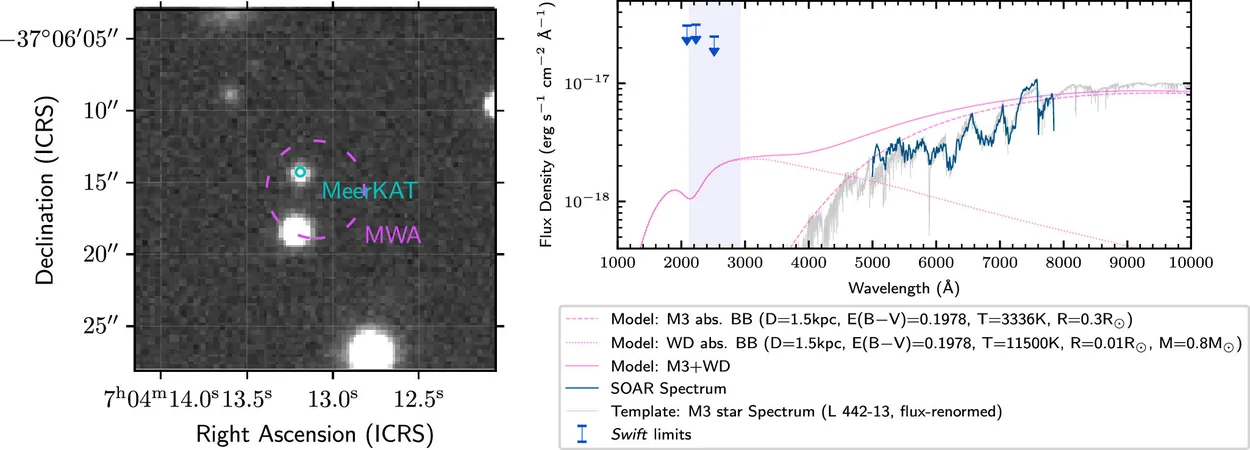
Astronomers Unveil Historic Discovery of Long-Period Radio Transient—What It Means for Understanding Deep Space!
2024-11-26
Author: Arjun
In a groundbreaking revelation from the field of astrophysics, researchers at the Curtin node of the International Center for Radio Astronomy Research (ICRAR) have potentially unlocked the mystery surrounding the longest-period radio transient ever detected—an extraordinary celestial event that has piqued the interest of scientists worldwide.
Published in *The Astrophysical Journal Letters*, the study led by Associate Professor Natasha Hurley-Walker and then-undergraduate student Csanád Horváth highlights an astonishing pulse of bright energy emerging from the depths of space, detected amongst archival low-frequency data from the Murchison Widefield Array (MWA) telescope. This enigmatic pulse—designated GLEAM-X J0704-37—operates on a three-hour cycle, emitting bursts of energy lasting between 30 to 60 seconds.
Long-period radio transients, previously a little understood phenomenon in the realm of astrophysics, have only recently begun to garner scientific scrutiny. Until now, researchers were challenged by the presence of numerous stars in our galaxy, which obscured the true sources of radio wave activity. However, the newly discovered transient lies in a less crowded region of the Puppis constellation, approximately 5,000 light years away from Earth, providing a clearer view for astronomers to analyze.
Professor Hurley-Walker notes the excitement surrounding this discovery, stating, “For astronomers to understand these long-period transients, we require an optical image. Yet, when observing them, we're immediately faced with an overwhelming number of stars—like the scene in '2001: A Space Odyssey'—'My god, it’s full of stars!' But this transient, located far from the Galactic Plane, enabled us to pinpoint the source of the radio waves.”
Utilizing the advanced capabilities of the MeerKAT telescope in South Africa, the research team successfully identified the radio waves' origins from a particular star system. They further analyzed the star using the SOAR observatory in Chile, revealing it to be a low-mass star, categorized as an "M dwarf."
However, here’s the twist—an M dwarf alone wouldn’t account for the substantial energy emissions observed. Hurley-Walker explains that M dwarfs are quite common, representing about 70% of the stars in the Milky Way, yet they remain invisible to the naked eye due to their low mass and luminosity. The data suggests that the M dwarf is part of a binary star system, likely coupled with a white dwarf—the remnant core of a dying star—that together generates the impressive radio emissions.
The significance of this discovery is monumental. The scientists are currently engaged in follow-up observations that will unequivocally determine the nature of this star system, shedding light on the intricate dance of celestial bodies in our universe.
Further digging through the MWA archives reveals that GLEAM-X J0704-37 has been active for at least 10 years, possibly existing unnoticed for even longer, suggesting that many more radio transients are waiting to be identified in observatories around the globe.
Professor Steven Tingay, director of the MWA, emphasized the importance of this research: “These long-period radio transients represent new, exciting frontiers in astronomy. The MWA has essentially paved the way for these revolutionary discoveries, holding a staggering 55-petabyte repository of observational data—a treasure trove for astronomers seeking to unveil more cosmic phenomena.”
With such a vast archive at their disposal—comparable to the storage capacity of 55,000 high-end home computers—astronomers are poised on the brink of unraveling many more mysteries of the universe. Stay tuned, as scientists continue to delve into the depths of space, where every discovery could redefine our understanding of the cosmos!

 Brasil (PT)
Brasil (PT)
 Canada (EN)
Canada (EN)
 Chile (ES)
Chile (ES)
 España (ES)
España (ES)
 France (FR)
France (FR)
 Hong Kong (EN)
Hong Kong (EN)
 Italia (IT)
Italia (IT)
 日本 (JA)
日本 (JA)
 Magyarország (HU)
Magyarország (HU)
 Norge (NO)
Norge (NO)
 Polska (PL)
Polska (PL)
 Schweiz (DE)
Schweiz (DE)
 Singapore (EN)
Singapore (EN)
 Sverige (SV)
Sverige (SV)
 Suomi (FI)
Suomi (FI)
 Türkiye (TR)
Türkiye (TR)